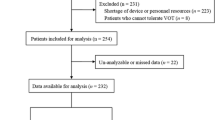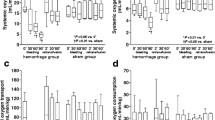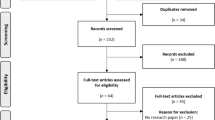Abstract
The purpose of the study is to investigate the relationship between microvascular reactivity and postoperative bleeding in cardiac surgery. The authors retrospectively analyzed a prospectively collected registry of cardiac surgery patients. Data from 154 patients enrolled in the registry were analyzed. A linear mixed model was performed to evaluate the association between the amount of postoperative chest tube output (CTO, milliliter, repeatedly measured at 0–8, 8–24, and 24–48 h) and tissue oxygen saturation (StO2) recovery slope (%/s) measured by vascular occlusion test (VOT) at skin closure. A logistic regression was carried out to see the relationship between StO2 recovery slope and packed red blood cell (PRBC) transfusion during the 48-h postoperative period. In the multivariable adjusted model, the effect of StO2 recovery slope on postoperative CTO (log-transformed) was statistically significant, and the degree of StO2 recovery slope was inversely related to the amount of CTO (exp(estimate) = 0.935; exp(95% CI) 0.881–0.992; p = 0.027). StO2 recovery slope was also inversely associated with postoperative PRBC transfusion possibility (OR = 0.795; 95% CI 0.633–0.998; p = 0.048). Microvascular reactivity measured by VOT is independently and inversely associated with postoperative bleeding in patients undergoing cardiac surgery.


Similar content being viewed by others
References
Parry GC, Mackman N. NF-kappaB mediated transcription in human monocytic cells and endothelial cells. Trends Cardiovasc Med. 1998;8:138–142.
Lindmark E, Tenno T, Siegbahn A. Role of platelet P-selectin and CD40 ligand in the induction of monocytic tissue factor expression. Arterioscler Thromb Vasc Biol. 2000;20:2322–2328.
Devaraj S, Xu DY, Jialal I. C-reactive protein increases plasminogen activator inhibitor-1 expression and activity in human aortic endothelial cells: implications for the metabolic syndrome and atherothrombosis. Circulation. 2003;107:398–404.
Ten VS, Pinsky DJ. Endothelial response to hypoxia: physiologic adaptation and pathologic dysfunction. Curr Opin Crit Care. 2002;8:242–50.
De Blasi RA, Palmisani S, Alampi D, Mercieri M, Romano R, Collini S, Pinto G. Microvascular dysfunction and skeletal muscle oxygenation assessed by phase-modulation near-infrared spectroscopy in patients with septic shock. Intensive Care Med. 2005;31:1661–8.
Lima A, van Bommel J, Jansen TC, Ince C, Bakker J. Low tissue oxygen saturation at the end of early goal-directed therapy is associated with worse outcome in critically ill patients. Crit Care. 2009;13(Suppl 5):S13.
Lima A, van Bommel J, Sikorska K, van Genderen M, Klijn E, Lesaffre E, Ince C, Bakker J. The relation of near-infrared spectroscopy with changes in peripheral circulation in critically ill patients. Crit Care Med. 2011;39:1649–54.
Shapiro NI, Arnold R, Sherwin R, et al. The association of near-infrared spectroscopy-derived tissue oxygenation measurements with sepsis syndromes, organ dysfunction and mortality in emergency department patients with sepsis. Crit Care. 2011;15:R223.
Cohn SM, Nathens AB, Moore FA, et al. Tissue oxygen saturation predicts the development of organ dysfunction during traumatic shock resuscitation. J Trauma. 2007;62:44–54.
Kim TK, Cho YJ, Min JJ, Murkin JM, Bahk JH, Hong DM, Jeon Y. Microvascular reactivity and clinical outcomes in cardiac surgery. Crit Care. 2015;19:316.
Kim TK, Cho YJ, Min JJ, Murkin JM, Bahk JH, Hong DM, Jeon Y. Tissue microcirculation measured by vascular occlusion test during anesthesia induction. J Clin Monit Comput. 2016;30:41–50.
Skarda DE, Mulier KE, Myers DE, Taylor JH, Beilman GJ. Dynamic near-infrared spectroscopy measurements in patients with severe sepsis. Shock. 2007;27:348–53.
Doerschug KC, Delsing AS, Schmidt GA, Haynes WG. Impairments in microvascular reactivity are related to organ failure in human sepsis. Am J Physiol Heart Circ Physiol. 2007;293:H1065–H1071.
Zipperle J, Schlimp CJ, Holnthoner W, Husa AM, Nurnberger S, Redl H, Schochl H. A novel coagulation assay incorporating adherent endothelial cells in thromboelastometry. Thromb Haemost. 2013;109:869–77.
Reinhofer M, Brauer M, Franke U, Barz D, Marx G, Losche W. The value of rotation thromboelastometry to monitor disturbed perioperative haemostasis and bleeding risk in patients with cardiopulmonary bypass. Blood Coagul Fibrinolysis. 2008;19:212–9.
Whiting D, DiNardo JA. TEG and ROTEM: technology and clinical applications. Am J Hematol. 2014;89:228–32.
Ji SM, Kim SH, Nam JS, Yun HJ, Choi JH, Lee EH, Choi IC (2015) Predictive value of rotational thromboelastometry during cardiopulmonary bypass for thrombocytopenia and hypofibrinogenemia after weaning of cardiopulmonary bypass. Kor. J Anesthesiol 68:241–248.
Girdauskas E, Kempfert J, Kuntze T, Borger MA, Enders J, Fassl J, Falk V, Mohr FW. Thromboelastometrically guided transfusion protocol during aortic surgery with circulatory arrest: a prospective, randomized trial. J Thorac Cardiovasc Surg. 2010;140:1117–24.
Weber CF, Gorlinger K, Meininger D, Herrmann E, Bingold T, Moritz A, Cohn LH, Zacharowski K. Point-of-care testing: a prospective, randomized clinical trial of efficacy in coagulopathic cardiac surgery patients. Anesthesiology. 2012;117:531–47.
Wikkelso A, Wetterslev J, Moller AM, Afshari A. Thromboelastography (TEG) or thromboelastometry (ROTEM) to monitor haemostatic treatment versus usual care in adults or children with bleeding. Cochrane Database Syst Rev. 2016. doi:10.1002/14651858.CD007871.pub3.
Lowenberg EC, Meijers JC, Levi M. Platelet-vessel wall interaction in health and disease. Neth J Med. 2010;68:242–51.
van Hinsbergh VW. Endothelium—role in regulation of coagulation and inflammation. Semin Immunopathol. 2012;34:93–106.
Yan SF, Mackman N, Kisiel W, Stern DM, Pinsky DJ. Hypoxia/hypoxemia-induced activation of the procoagulant pathways and the pathogenesis of ischemia-associated thrombosis. Arterioscler Thromb Vasc Biol. 1999;19:2029–35.
Christensen MC, Dziewior F, Kempel A, von Heymann C. Increased chest tube drainage is independently associated with adverse outcome after cardiac surgery. J Cardiothorac Vasc Anesth. 2012;26:46–51.
Stone GW, Clayton TC, Mehran R, Dangas G, Parise H, Fahy M, Pocock SJ. Impact of major bleeding and blood transfusions after cardiac surgery: analysis from the Acute Catheterization and Urgent Intervention Triage strategY (ACUITY) trial. Am Heart J. 2012;163:522–9.
Koch CG, Li L, Duncan AI, Mihaljevic T, Loop FD, Starr NJ, Blackstone EH. Transfusion in coronary artery bypass grafting is associated with reduced long-term survival. Ann Thorac Surg. 2006;81:1650–7.
Surgenor SD, Kramer RS, Olmstead EM, et al. The association of perioperative red blood cell transfusions and decreased long-term survival after cardiac surgery. Anesth Analg. 2009;108:1741–6.
Herwaldt LA, Swartzendruber SK, Edmond MB, Embrey RP, Wilkerson KR, Wenzel RP, Perl TM. The epidemiology of hemorrhage related to cardiothoracic operations. Infect Control Hosp Epidemiol. 1998;19:9–16.
Winkelmayer WC, Levin R, Avorn J. Chronic kidney disease as a risk factor for bleeding complications after coronary artery bypass surgery. Am J Kidney Dis. 2003;41:84–9.
Chakravarthy M, Muniraj G, Patil S, Suryaprakash S, Mitra S, Shivalingappa B. A randomized prospective analysis of alteration of hemostatic function in patients receiving tranexamic acid and hydroxyethyl starch (130/0.4) undergoing off pump coronary artery bypass surgery. Ann Card Anaesth. 2012;15:105–10.
Carroll RC, Chavez JJ, Snider CC, Meyer DS, Muenchen RA. Correlation of perioperative platelet function and coagulation tests with bleeding after cardiopulmonary bypass surgery. J Lab Clin Med. 2006;147:197–204.
Ferraris VA, Gildengorin V. Predictors of excessive blood use after coronary artery bypass grafting. A multivariate analysis. J Thorac Cardiovasc Surg. 1989;98:492–7.
Hecht-Dolnik M, Barkan H, Taharka A, Loftus J. Hetastarch increases the risk of bleeding complications in patients after off-pump coronary bypass surgery: a randomized clinical trial. J Thorac Cardiovasc Surg. 2009;138:703–11.
Author information
Authors and Affiliations
Corresponding author
Ethics declarations
Conflict of interest
Hippo Medical Company (Seoul, Korea) and Hutchinson (MN, USA) provided the Inspectra™ StO2 tissue oxygenation monitor to Yunseok Jeon. The remaining authors declare that they have no conflict of interest.
Ethical approval
For this type of study formal consent is not required. This analysis was approved by the Institutional Review Board of Seoul National University Hospital, and written informed consent was waived (IRB #1512-046-727).
Informed consent
For this type of study formal consent is not required. Written informed consent was waived under approval of the Institutional Review Board of Seoul National University Hospital (IRB #1512-046-727).
Rights and permissions
About this article
Cite this article
Nam, K., Oh, HM., Koo, CH. et al. Microvascular reactivity measured by vascular occlusion test is an independent predictor for postoperative bleeding in patients undergoing cardiac surgery. J Clin Monit Comput 32, 295–301 (2018). https://doi.org/10.1007/s10877-017-0020-4
Received:
Accepted:
Published:
Issue Date:
DOI: https://doi.org/10.1007/s10877-017-0020-4




